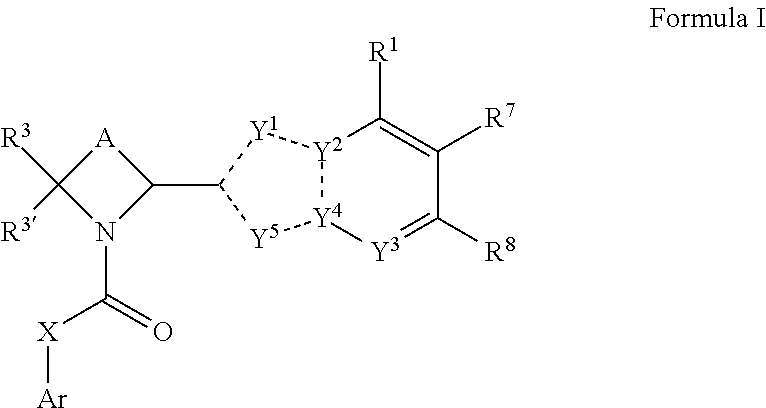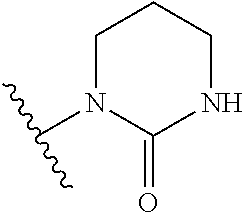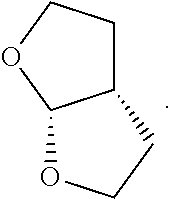Compounds and methods for antiviral treatment
a technology of compound and method, applied in the field of compound and method for antiviral treatment, can solve the problems of inability to prevent hrsv infection, inability to use general use vaccines, and inability to treat hrsv infections,
- Summary
- Abstract
- Description
- Claims
- Application Information
AI Technical Summary
Benefits of technology
Problems solved by technology
Method used
Image
Examples
example 1a
Preparation of Intermediate 1
[0452]
[0453]A solution of 1-ethoxy-propene (5.1 mL, 46 mmol) in pyridine (3.4 mL) was added slowly via addition funnel (˜1 drop / sec) to neat trichloroacetyl chloride (4.7 mL, 42 mmol) at −10° C. under an argon atmosphere. The reaction mixture was then allowed to slowly warm to 23° C. After 20 h, the reaction mixture was diluted with dichloromethane (50 mL) and the resulting mixture was washed with 0.01N HCl (3×50 mL) and brine (50 mL), was dried over anhydrous sodium sulfate, and was concentrated under reduced pressure. To the crude residue was added sodium ethoxide (21 wt % in ethanol, 7.1 g, 44 mmol) slowly via syringe. After 30 min, the reaction mixture was partitioned between dichloromethane (500 mL) and water (500 mL). The phases were split and the aqueous layer was extracted with dichloromethane (500 mL). The combined organic extracts were dried over anhydrous sodium sulfate, and were concentrated to afford intermediate 1 (6.8 g, 95%) as an orange ...
example 1b
Preparation of Intermediate 2
[0455]
[0456]N-Boc-(S)-piperidine-2-carboxylic acid (5.0 g, 22 mmol) in DMF (100 mL) was treated with Cs2CO3 (3.5 g, 10.9 mmol) and MeI (1.5 mL, 24 mmol). The mixture was stirred for 4 hours and diluted with MTBE (250 mL). The mixture was washed with water (twice with 100 mL) and saturated sodium chloride solution (100 mL). The solution was dried over anhydrous sodium sulfate and concentrated to afford the ester intermediate 2 (5.1 g crude, 96%) as an oil which was used without further purification
[0457]1H NMR (CDCl3, 300 MHz): δ 4.80 (m, 1H), 3.97 (m, 1H), 3.73 (s, 3H), 2.93 (m, 1H), 2.18 (app d, J=13.2 Hz, 1H), 1.67 (m, 2H), 1.45 (br s, 10H), 1.20 (app t, J=13.5 Hz, 1H).
[0458]Rf=0.90 (30% EtOAc-hexanes);
example 2
Preparation of Intermediate 3
[0459]
[0460](S)-1-Boc-piperidine-2-carboxylic acid (25 g, 109 mmol, Sigma-Aldrich) in DMF (500 mL) was treated sequentially with MeNHOMe.HCl (11.2 g, 115 mmol), N-methylmorpholine (36 mL, 327 mmol), HOBt (16.2 g, 120 mmol), and EDCI (23 g, 120 mmol) and stirred for 18 h. The solution was diluted with EtOAc (1000 mL) and washed with H2O (twice with 500 mL) and saturated NaCl solution (500 mL). The solution was dried over MgSO4, filtered and concentrated. The residue was subjected to a 330 g SiO2 Combiflash High Performance Gold column (0-100% EtOAc-hexanes gradient) to afford the Weinreb amide intermediate 3 (18.4 g, 61%) as a clear oil:
[0461]1H NMR (CDCl3, 300 MHz): δ 5.06 (br m, 1H), 3.93 (br m, 1H), 3.77 (br s, 3H), 3.18 (s, 3H), 2.01 (app d, J=13.5 Hz, 1H), 1.71 (m, 4H), 1.45 (s, 9H);
[0462]LCMS (ESI) m / z 273 [M+H]+, tR=2.31 min;
[0463]HPLC (RP: 6-98% MeCN—H2O gradient, 0.05% TFA modifier) tR=4.423 min.
[0464]Rf=0.60 (50% EtOAc-hexanes);
PUM
| Property | Measurement | Unit |
|---|---|---|
| temperature | aaaaa | aaaaa |
| time | aaaaa | aaaaa |
| temperatures | aaaaa | aaaaa |
Abstract
Description
Claims
Application Information
 Login to View More
Login to View More - R&D
- Intellectual Property
- Life Sciences
- Materials
- Tech Scout
- Unparalleled Data Quality
- Higher Quality Content
- 60% Fewer Hallucinations
Browse by: Latest US Patents, China's latest patents, Technical Efficacy Thesaurus, Application Domain, Technology Topic, Popular Technical Reports.
© 2025 PatSnap. All rights reserved.Legal|Privacy policy|Modern Slavery Act Transparency Statement|Sitemap|About US| Contact US: help@patsnap.com



